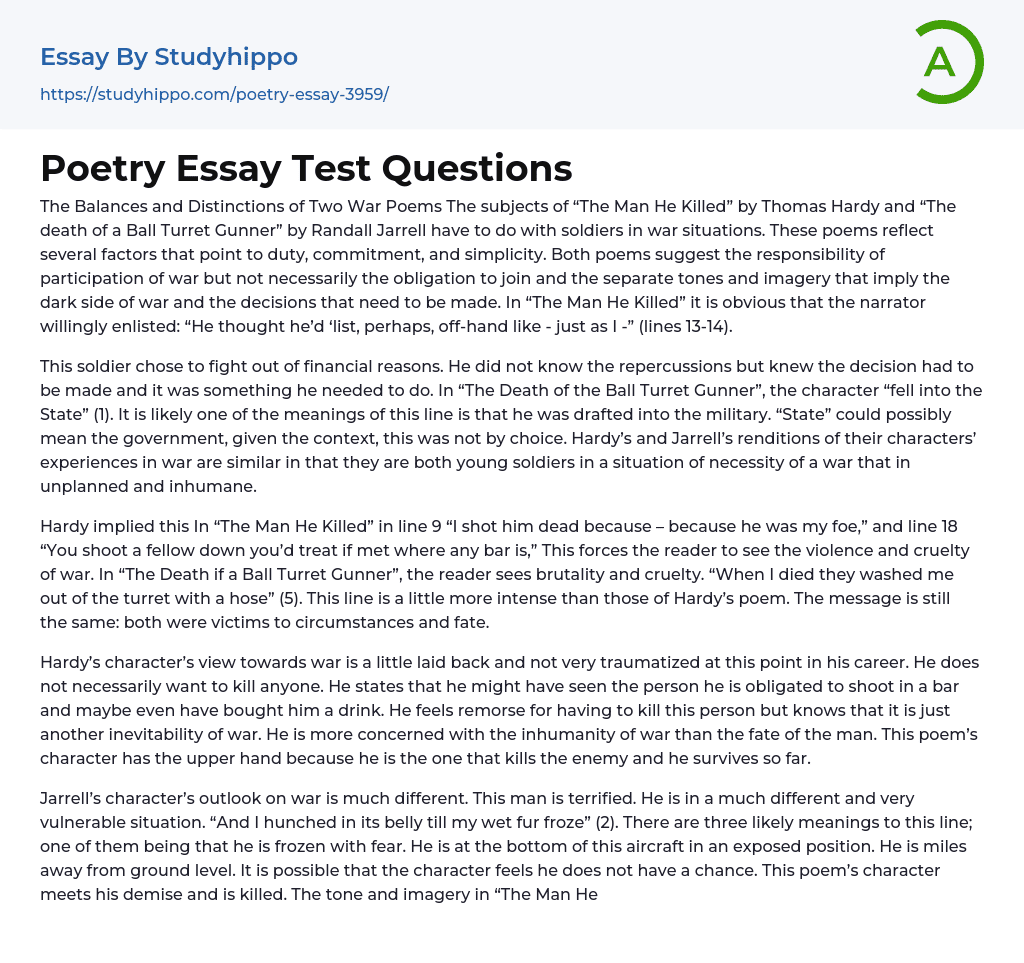The subjects of the war poems "The Man He Killed" by Thomas Hardy and "The Death of a Ball Turret Gunner" by Randall Jarrell revolve around soldiers in war. These poems explore themes of duty, commitment, and simplicity. Both poems suggest the responsibility of participating in war, but joining it is not seen as an obligation. Additionally, they convey separate tones and imagery that allude to the darker aspects of war and the difficult decisions that must be made. In "The Man He Killed," it is evident that the narrator enlisted willingly: "He thought he’d ‘list, perhaps, off-hand like - just as I -” (lines 13-14).
This soldier enlisted in the military for financial reasons without knowing the potential consequences. Despite the lack of choice, he recognized the need to act and made the decision to f
...ight. In “The Death of the Ball Turret Gunner,” the protagonist falls into the state, which is likely a reference to being drafted into the military. The term “state” in this context probably refers to the government, indicating that this enlistment was not voluntary. Both Hardy and Jarrell's depictions of their characters' wartime experiences portray young soldiers thrust into a necessary and cruel war without proper planning.
Hardy suggests that in his poem "The Man He Killed", the act of shooting someone dead simply because they are an enemy highlights the inherent violence and cruelty of war. He emphasizes this point in line 9: "I shot him dead because – because he was my foe," and again in line 18: "You shoot a fellow down you’d treat if met where any bar is." Similarly, in the poem "The Deat
of a Ball Turret Gunner," the reader witnesses further instances of brutality and cruelty. The line "When I died they washed me out of the turret with a hose" (5) portrays a heightened level of intensity compared to Hardy's poem. Nevertheless, the underlying message remains unchanged: both individuals were victims of their circumstances and fate.
The character portrayed by Hardy has a rather relaxed and non-traumatized perspective on war. He does not have a strong desire to take someone's life. He mentions the possibility of having encountered the person he is obligated to shoot in a bar, and even buying them a drink. He experiences remorse for having to end this person's life, but acknowledges that it is simply another unavoidable aspect of war. His primary concern lies in the inhumane nature of war, rather than the fate of the individual. In this poem, the character holds the advantage because he is the one who successfully kills the enemy and manages to survive thus far.
Jarrell's character in the poem has a completely different perspective on war, as he is a terrified and vulnerable man. The line "And I hunched in its belly till my wet fur froze" (2) can be interpreted in three ways, one of them being that he is frozen with fear. He is situated at the bottom of an aircraft in an exposed position, miles away from the safety of the ground. It seems like the character believes he has no chance of survival. Ultimately, the character meets his demise and is killed. The tone and imagery used in "The Man He Killed" create a fast-paced and simplistic atmosphere, while also maintaining a
somewhat playful undertone.
Both poems, "The Death of the Ball Turret Gunner" and the untitled poem, depict the drawbacks of war while acknowledging its futility and senselessness. In the untitled poem, the speaker refers to war as "quaint and curious" (17), adopting a conversational tone with the use of speech marks. The tone in "The Death of the Ball Turret Gunner" is melancholic, with minimal use of quotation. Dark and depressing imagery such as "wet fur" (2), "black flack" (4), "nightmare fighters," and being "washed out of the turret" (5) vividly capture the horrifying aspects of war. Despite their differences, both poems are straightforward and easily comprehensible, employing informal diction, middle diction, dialect, and jargon.
These poems are characterized by simplicity and lack of complexity. Both "The Man He Killed" and "The Death of a Ball Turret Gunner" convey the theme of war and its brutality. It is easy to relate to the emotions of the soldiers and sympathize with their situation. Both poems highlight the absurdity of war and the soldiers' sense of obligation to follow orders. However, they differ in tone, with one being upbeat and lighthearted while the other is gloomy and slow-paced, despite having few stanzas.
- Book Summary essays
- Metaphor essays
- Reader essays
- Rhyme essays
- Literary devices essays
- Villain essays
- Books essays
- Genre essays
- Literary Criticism essays
- Writer essays
- Protagonist essays
- Simile essays
- Poem essays
- Book Report essays
- Book Review essays
- Greek Mythology essays
- Plot essays
- Tragic Hero essays
- Coming of Age essays
- Play essays
- Rhetoric essays
- Rhetorical Question essays
- Translation essays
- Understanding essays
- Reason essays
- Character essays
- Letter essays
- American Literature essays
- Literature Review essays
- Utopia essays
- Poetry Analysis essays
- Dante's Inferno essays
- Between The World and Me essays
- Incidents in The Life of a Slave Girl essays
- Flowers for Algernon essays
- Myth essays
- Everyday Use essays
- Boo Radley essays
- Genesis essays
- Richard iii essays
- Alice in Wonderland essays
- On the road essays
- Ozymandias essays
- The Nightingale essays
- Holden Caulfield essays
- Animal Farm essays
- 1984 essays
- A Hanging essays
- Shooting An Elephant essays
- A Tale Of Two Cities essays




